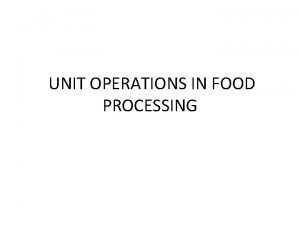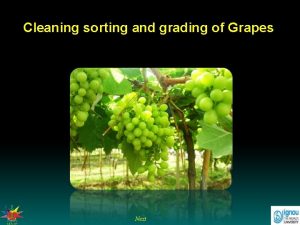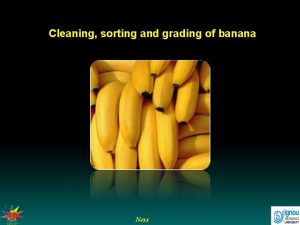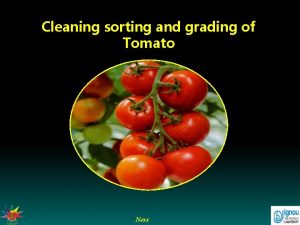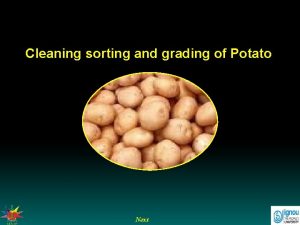Cleaning sorting and grading of Grapes Next Cleaning













- Slides: 13

Cleaning sorting and grading of Grapes Next

Cleaning sorting and grading of Grapes Introduction • • • Grapes are non-climacteric fruit that grow on the perennial and deciduous woody vines Grape is third most widely cultivated fruit crop after banana & citrus. It is a temperate crop which has got adapted to sub-tropical climate of peninsular India has the distinction of achieving the highest productivity in grapes in the world, with an average yield of 30 t/ha. Good quality table grapes must have a good shelf life & bberries should be firm, have a crisp texture when eaten, good flavour and an even colour End Next

Cleaning sorting and grading of Grapes Steps for Postharvest Management of Grapes Harvesting Packaging & Labeling Transportation End Clipping & Sorting Pre-cooling Grading Storage Consumer Marketing Previous Next

Cleaning sorting and grading of Grapes Care during harvesting ? • • • Grapes meant for table purpose should not be harvested until ready to eat, since they do not ripen after harvest. They should be picked only after they reach the optimum stage of acceptability in appearance, flavour and texture. Key criterion for harvesting are: o Color of berries & o Sugar content Before harvest, it is necessary to prune long shoots or strip leaves to allow for better grape coloration and offer pickers easier access to the fruit Harvest the berries on the coolest time of the day (early morning). Harvesting of berries must stop once the pulp temperature reaches 28 o. C. If rain wet the cluster thoroughly, it is important to suspend/delay the harvesting operation so as to avoid the fungus infection thereafter. End Previous Next

Cleaning sorting and grading of Grapes Cleaning / Clipping, Sorting of Grapes Immediately after harvesting grapes are brought into clipping & grading area where clipper removes the berries which have the following defects: sunburn, rot, decay, bird damage, insect damage, Powdery Mildew, fruit fly or wasp damage, uneven berries and any other defects that detract from the general appearance and may cause phytosanitary problems in the receiving market. End Previous Next

Cleaning sorting and grading of Grapes Common defects in Grapes that needs to be removed during clipping Decay Split Berries Sun Burn Fruit Fly Damage Insect Damage Powdery Mildew Infested by Mealy Bug Source: httpwww. rootsofpeace. orgdocuments. Afghan_Grape_Post_Harvest_Manual_Jan-2010. pdf End Previous Next

Cleaning sorting and grading of Grapes Mechanical sorting of grapes Bunches of grapes are being weighed & classified to colour & size Source: http: //www. sybu. co. za/sd/sites/defau/files/story/grapes_purple. png End Previous Next

http: //www. youtube. com/watch? v=a. XXT 6 Xgx. X 5 U (grapes sorting grading) Cleaning sorting and grading of Grapes Grading means the sorting of the homogenous lots of the produce according to the fixed grade standards. Produce is graded in accordance with the various quality factors. The harvested bunches of grapes are graded as per their size of the berries and their colour. Grading is one of the most important procedures to be followed in post-harvest handling as it determines the quality, shelf life and price of the fruits. In grading the produce is sorted according to the fixed grade standard, taking into consideration various quality factors to make a homogenous lot. Click the following link to see the videos for sorting grading of grapes http: //www. youtube. com/watch? v=a. XXT 6 Xgx. X 5 U http: //www. youtube. com/watch? v=o 5 Vae. AMg 7 Tw&feature=related End Previous Next

Cleaning sorting and grading of Grapes Sorting & Grading: AGMARK Standards SCHEDULE – II GRADE DESIGNATION AND QUALITY OF TABLE GRAPES i. 1. Table Grapes shall be fruits obtained from varieties (cultivars) of Vitis vinifera L. ii. 2. Minimum requirements: i. Bunches and berries of Table grapes shall be: 1. a. clean, sound, free of any visible foreign matter; 2. b. free of pests, affecting the general appearance of the produce; 3. c. free of damage caused by pests and diseases; 4. d. free of abnormal external moisture; 5. e. free of any foreign smell and / or taste; i. f. free of all visible traces of moulds; ii. Berries shall be intact, well formed and normally developed, iii. Table grapes shall comply with the residue levels of heavy metals, pesticides and other food safety parameters as laid down by the Codex Alimentarius Commission for exports. iv. Table grapes shall have minimum soluble solids of 16 degrees Brix. v. Table grapes shall have minimum sugar / acid ratio of 20 : 1. End Previous Next

Cleaning sorting and grading of Grapes Contd… Grade designati on 1 Extra class Class I Grade requirements Provision Grade tolerances concerning sizing 2 3 4 Grapes must be of superior quality. The bunches must As per table 5% by weight of bunches not be typical of variety in shape, development and coloring ‘A’ satisfying the requirements of and have no defects. Berries must be firm, firmly the grade, but meeting those of attached to the stalk, evenly spaced along the stalk and class I grade or exceptionally have their bloom virtually intact. coming within the tolerances of that grade. Grapes must be of good quality. The bunches must be -do 10% by weight of bunches not typical of variety in shape, development and coloring. satisfying the requirements of Berries must be firm, firmly attached to the stalk and, as the grade, but meeting those of far as possible, have their gloom intact. They may, class II grade or exceptionally however, be less evenly spaced along the stalk than in coming within the tolerance of the extra class. Following slight defects may be there, that grade. providing these do not affect the general appearance of the produce and keeping quality of the package. - a slight defect in shape. - a slight defect in coloring End Previous Next

Cleaning sorting and grading of Grapes Contd… Grade designation Grade requirements Provision concernin g sizing Grade tolerances 1 2 3 4 The bunches may show defects in shape, development and coloring provided these do not impair the essential characteristics of the variety. The berries must be sufficiently firm and sufficiently attached. They may be less evenly spaced along the stalk than Class I grade. Following defects may be there, provided these do not affect the general appearance of the produce and keeping quality of the package. -do- 10% by weight of bunches not satisfying the requirements of the grade, but meeting the minimum requirements. Class II End - defects in shape - defects in coloring only, slight sun scorch affecting the skin - slight bruising, - slight skin defects Previous Next

Cleaning sorting and grading of Grapes Other requirements: 1. i. Grapes must have been carefully picked and have reached an appropriate degree of development and ripeness in accordance with criteria proper to the variety and / or commercial type and to the area in which they are grown. The development and condition of the Grapes must be such as to enable them : - to withstand transport and handling, and - to arrive in satisfactory condition at the place of destination. TABLE ‘A’ PROVISION CONCERNING SIZING Size is determined by the weight of bunches (in gms). The following minimum (in gms) requirements per bunch are laid down for large and small berries grapes. • 2. Grade Large berries Small berries Extra class 200 150 Class I 150 100 Class II 100 75 Size tolerance: Extra Class, Class II: 10% by weight of bunches not satisfying the size requirements for the grade, but meeting the size requirements for the grade immediately below End Previous Next

Cleaning sorting and grading of Grapes Let us sum up • Grape is an one of most important but perishable fruit grown globally. • They should be harvested only when ready to eat. • Clipping & grading is important step for postharvest handling of grapes • Sorting & Grading in India is generally done manually while mechanized grading based on size and weight is also practiced. • AGMARK specifies 3 weight grades of Large berries i. e. Extra Class (200 g), Class I (150 g), Class II (100 g) and similarly for Small berries 150, 100 & 75 g respectively End Previous
 X.next = x.next.next
X.next = x.next.next What is internal and external sorting
What is internal and external sorting Difference between sorting and grading
Difference between sorting and grading Sorting and grading in food processing
Sorting and grading in food processing Grading of grapes
Grading of grapes The fox and the grapes genre and subgenre
The fox and the grapes genre and subgenre A hot summer day fox and goat story
A hot summer day fox and goat story The developing person through the life span 9th edition
The developing person through the life span 9th edition Grapes and figs
Grapes and figs Envelope nuclear
Envelope nuclear Compare between bubble sort and selection sort.
Compare between bubble sort and selection sort. Searching and sorting arrays in c++
Searching and sorting arrays in c++ Searching and sorting in java
Searching and sorting in java Orale charakterstruktur
Orale charakterstruktur



